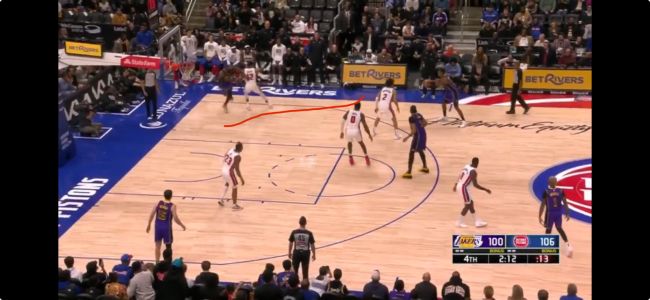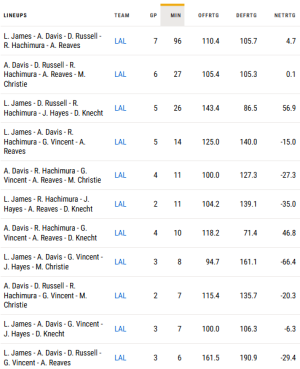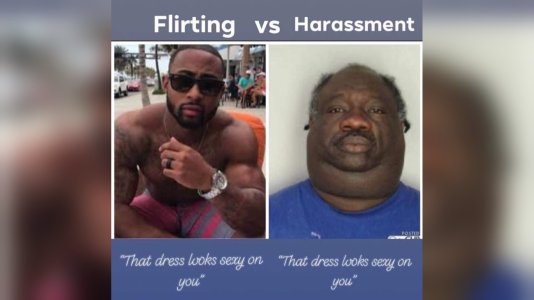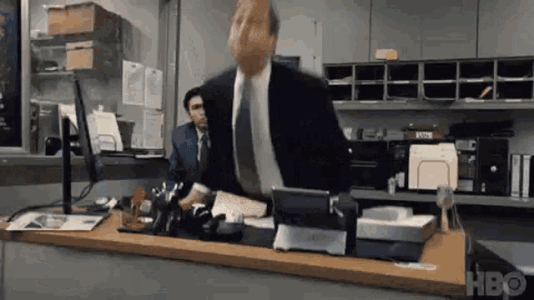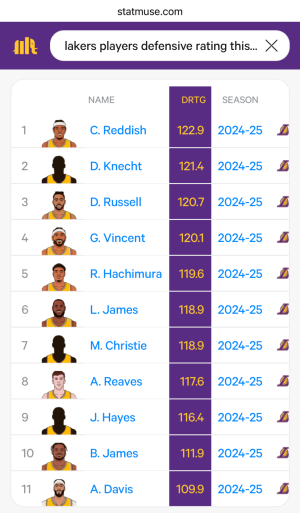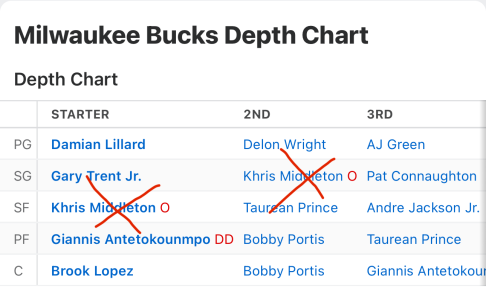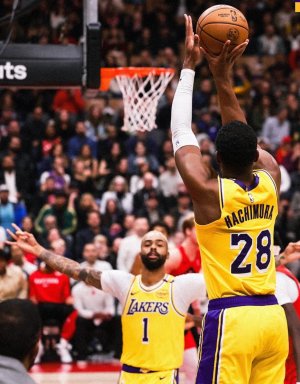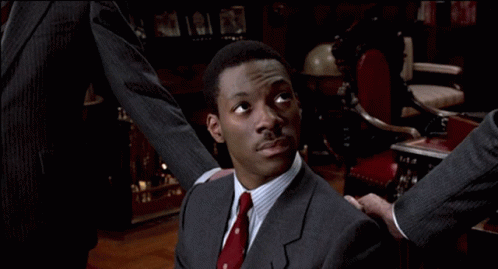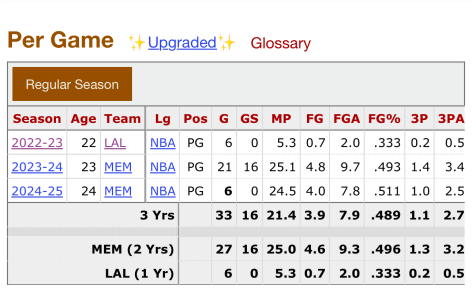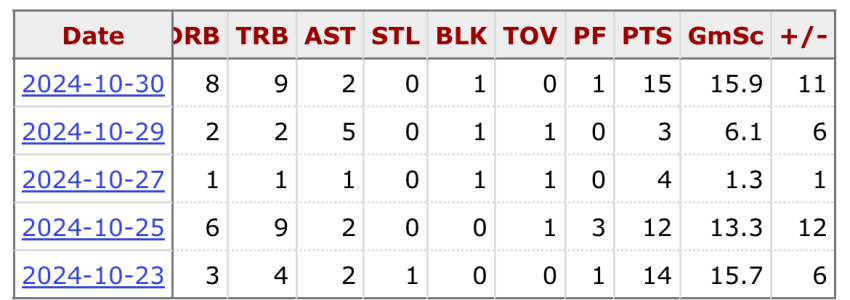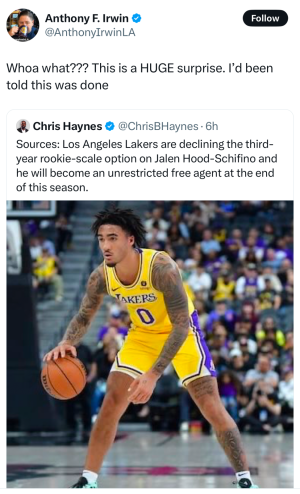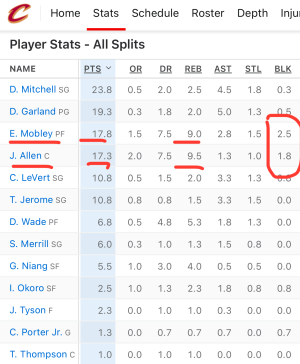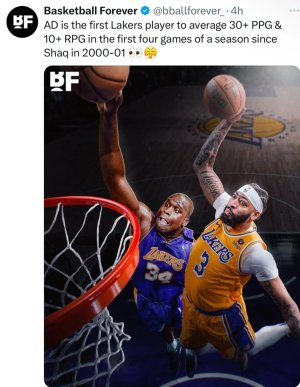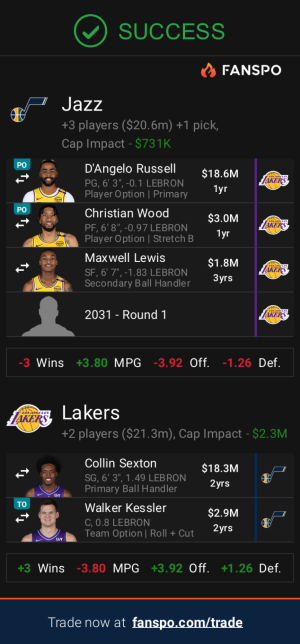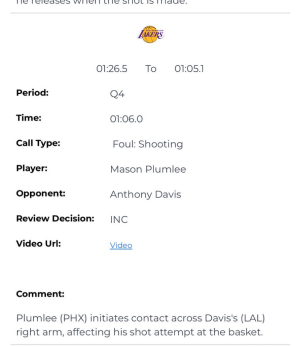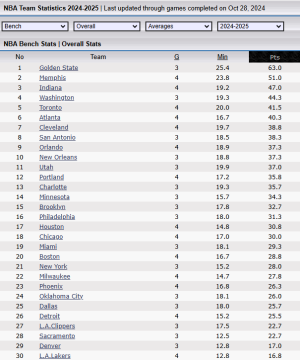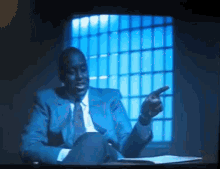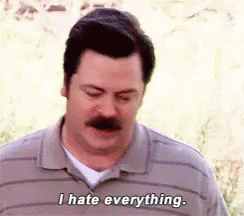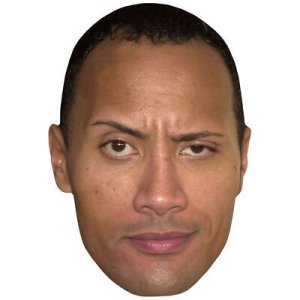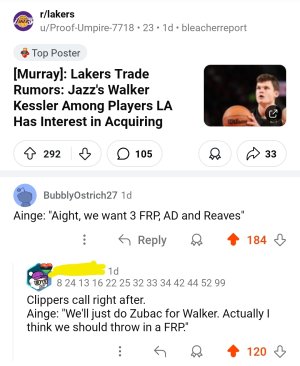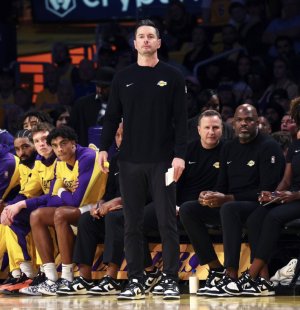- 92,381
- 128,157
Lakers’ existential question seems no closer to an answer
As LeBron James closes in on Kareem Abdul-Jabbar’s all-time scoring record, another fun fact looms for later this spring: James is closing in on owning virtually every cumulative playoff record imaginable. He has already left Abdul-Jabbar in the dust in playoff points, and he also leads in games, minutes, field goals, free throws, turnovers, steals and win shares.
The next item on the radar is the tantalizingly close record for playoff 2-point baskets; James trails Abdul-Jabbar by just 63. He also trails Magic Johnson by only two for the record for playoff triple-doubles.
Surely he could pass both in a single playoff series … if he gets the opportunity to play in one.
Will this team give him that opportunity?
Thursday’s game between Indiana and Los Angeles was an interesting reminder of the state of affairs for the Lakers. For as great as James has been and continues to be (he had 26 points, seven rebounds and seven assists), the (mostly Lakers) fans in Gainbridge Fieldhouse were left watching a nip-and-tuck battle to the wire between the teams that began the night tied for the 21st-best record in the 30-team NBA.
The Lakers eked out a 112-111 win, yes, but it moved them from 13th place all the way to … 12th. James’ presence still hasn’t been enough to offset glaring weaknesses up and down the rest of the roster, with the Lakers an even 21-21 when he plays (and 4-7 when he doesn’t, which was rumored to be the case prior to tipoff before he decided to play through a nagging foot problem).
Thus, with a week before the trade deadline, we feel no closer to an answer to the Lakers’ great existential question than we were on opening night. To wit, is this a team worth salvaging? Or are the Lakers better off taking their medicine, visiting the lottery and trying again next season?
Thursday’s opponent only underscored that state of affairs. The Indiana Pacers were originally thought to be tanking yet began the game with the same record as L.A. Moreover, two of the Pacers’ key starters, Myles Turner and Buddy Hield, were originally rumored to be potential targets for the Lakers in return for unprotected first-round picks in 2027 and 2029. (Those are the earliest picks the Lakers can legally trade before the deadline.)
Turner’s recent renegotiation-and-extension deal with Indy likely takes that trade possibility off the table*, but that is hardly the only possibility out there for L.A. The Lakers are sitting on multiple large, expiring contracts, most notably those of Russell Westbrook ($47 million) and Patrick Beverley ($13 million), and in addition to the two future firsts, they can still move future seconds in 2023, 2024, 2025 and 2027.
(*Extended cap nerd sidebar: Although Turner’s new deal is theoretically not subject to a six-month trade restriction the way some extensions are, I’ve also talked to a well-connected source who thinks the league office would make a huge frowny face if the Pacers were to turn around and trade him so quickly after inking a renegotiate-and-extend deal unless it were to another team that would have been able to renegotiate and extend him. San Antonio is the only such team, and that isn’t happening. However, if the Pacers trade him in June, still inside six months, it would likely be a different story; it would be much harder for the league office to argue there were cap-circumventing shenanigans given the time between transactions.)
Of course, the Lakers already gave us a partial answer to this existential question when they traded three second-round picks to Washington for Rui Hachimura. Most of my league sources, given anonymity so they could speak freely, pegged this as a 2023 free-agency move more than an in-season roster makeover, and if so, it could be a signal that L.A. intends to keep pushing in chips rather than accumulate 2023 cap space.
The latest hot idea making the rounds — and I will emphasize that this idea has been fairly heavily trafficked in theory despite little evidence that it’s been discussed in reality — is the notion of trading Westbrook and the future firsts to Toronto, unprotected, in return for Klutch client Gary Trent Jr. and likely future Klutch client Fred VanVleet. Both are likely free agents with player options on their deals, but presumably, the closeness of Klutch and the Lakers would make re-upping more palatable.
There are ways of splitting the baby, too. Would the Lakers consider trading Beverley and a single first in 2027, protected 1-4, and reverting to a 2027 second if not conveyed, in return for sharpshooter Trent? Such a move would let the Lakers operate as an over-the-cap team to re-sign Trent, the recently acquired Hachimura and Westbrook and retain the flexibility of using the first in 2029 and their 2023 first-rounder on draft night.*
(*The Lakers owe their 2023 first to New Orleans in a pick swap; however, they will have a first either way, either their own or that of the Pelicans. They cannot trade it until the night of the NBA Draft, however, because of the Stepien rule and the possibility of their 2024 pick conveying to the Pelicans. Waiting until draft night would also make it easier to write protections into a trade of the 2029 pick since it would be eligible to defer to 2030 at that point.)
Going down the over-the-cap pathway could also allow the Lakers to pursue another angle: extending Westbrook. They likely wouldn’t entertain this until trade angles are off the table, but consider the fact the Lakers could put him on next year’s books for, say, $15 million and would not have any trade restrictions on it (which isn’t the case if he re-signs in free agency).
Thus, Westbrook’s contract would continue to operate as a potential trade chip throughout the offseason (or on draft night) in that scenario, and if nothing materialized, they would just bring him back. Of course, Westbrook would have to agree to the deal. But that’s the move that might maximize L.A.’s offseason flexibility if it doesn’t want to be a cap space team, something that seems more likely in the wake of the Hachimura trade.
Are half-measures the answer, though? Is pushing a 12th-place team into the Play-In Tournament the endgame here, or are we aiming a bit higher? While it’s true the Western Conference standings are extremely compressed, even getting to 45 wins would require an impressive closing run from the Lakers.
Another argument would be to go for the cap space scenario and see what happens and only do the most boring thing possible at the trade deadline (Juan Toscano-Anderson, Wenyen Gabriel and cash to the Spurs would save millions in luxury tax payments. Wooooo, let’s goooooo!!!).
Which takes us back to the nightly torment of the Lakers. Watching James take over games or Anthony Davis casually swat away Tyrese Haliburton’s go-ahead layup attempt, it’s easy to believe in the idea that one or two more good players on a mostly replacement-level roster could make this one of the West’s better teams overnight. On the other hand, the stark math of where they stand and how far that leaves them from the league’s upper crust argues for the opposite course.
There’s only a week to decide, and the Lakers have only two games left before the trade deadline. And yet, 53 games into the season, we seem no closer to an answer to the defining question of the Lakers’ season.
As LeBron James closes in on Kareem Abdul-Jabbar’s all-time scoring record, another fun fact looms for later this spring: James is closing in on owning virtually every cumulative playoff record imaginable. He has already left Abdul-Jabbar in the dust in playoff points, and he also leads in games, minutes, field goals, free throws, turnovers, steals and win shares.
The next item on the radar is the tantalizingly close record for playoff 2-point baskets; James trails Abdul-Jabbar by just 63. He also trails Magic Johnson by only two for the record for playoff triple-doubles.
Surely he could pass both in a single playoff series … if he gets the opportunity to play in one.
Will this team give him that opportunity?
Thursday’s game between Indiana and Los Angeles was an interesting reminder of the state of affairs for the Lakers. For as great as James has been and continues to be (he had 26 points, seven rebounds and seven assists), the (mostly Lakers) fans in Gainbridge Fieldhouse were left watching a nip-and-tuck battle to the wire between the teams that began the night tied for the 21st-best record in the 30-team NBA.
The Lakers eked out a 112-111 win, yes, but it moved them from 13th place all the way to … 12th. James’ presence still hasn’t been enough to offset glaring weaknesses up and down the rest of the roster, with the Lakers an even 21-21 when he plays (and 4-7 when he doesn’t, which was rumored to be the case prior to tipoff before he decided to play through a nagging foot problem).
Thus, with a week before the trade deadline, we feel no closer to an answer to the Lakers’ great existential question than we were on opening night. To wit, is this a team worth salvaging? Or are the Lakers better off taking their medicine, visiting the lottery and trying again next season?
Thursday’s opponent only underscored that state of affairs. The Indiana Pacers were originally thought to be tanking yet began the game with the same record as L.A. Moreover, two of the Pacers’ key starters, Myles Turner and Buddy Hield, were originally rumored to be potential targets for the Lakers in return for unprotected first-round picks in 2027 and 2029. (Those are the earliest picks the Lakers can legally trade before the deadline.)
Turner’s recent renegotiation-and-extension deal with Indy likely takes that trade possibility off the table*, but that is hardly the only possibility out there for L.A. The Lakers are sitting on multiple large, expiring contracts, most notably those of Russell Westbrook ($47 million) and Patrick Beverley ($13 million), and in addition to the two future firsts, they can still move future seconds in 2023, 2024, 2025 and 2027.
(*Extended cap nerd sidebar: Although Turner’s new deal is theoretically not subject to a six-month trade restriction the way some extensions are, I’ve also talked to a well-connected source who thinks the league office would make a huge frowny face if the Pacers were to turn around and trade him so quickly after inking a renegotiate-and-extend deal unless it were to another team that would have been able to renegotiate and extend him. San Antonio is the only such team, and that isn’t happening. However, if the Pacers trade him in June, still inside six months, it would likely be a different story; it would be much harder for the league office to argue there were cap-circumventing shenanigans given the time between transactions.)
Of course, the Lakers already gave us a partial answer to this existential question when they traded three second-round picks to Washington for Rui Hachimura. Most of my league sources, given anonymity so they could speak freely, pegged this as a 2023 free-agency move more than an in-season roster makeover, and if so, it could be a signal that L.A. intends to keep pushing in chips rather than accumulate 2023 cap space.
The latest hot idea making the rounds — and I will emphasize that this idea has been fairly heavily trafficked in theory despite little evidence that it’s been discussed in reality — is the notion of trading Westbrook and the future firsts to Toronto, unprotected, in return for Klutch client Gary Trent Jr. and likely future Klutch client Fred VanVleet. Both are likely free agents with player options on their deals, but presumably, the closeness of Klutch and the Lakers would make re-upping more palatable.
There are ways of splitting the baby, too. Would the Lakers consider trading Beverley and a single first in 2027, protected 1-4, and reverting to a 2027 second if not conveyed, in return for sharpshooter Trent? Such a move would let the Lakers operate as an over-the-cap team to re-sign Trent, the recently acquired Hachimura and Westbrook and retain the flexibility of using the first in 2029 and their 2023 first-rounder on draft night.*
(*The Lakers owe their 2023 first to New Orleans in a pick swap; however, they will have a first either way, either their own or that of the Pelicans. They cannot trade it until the night of the NBA Draft, however, because of the Stepien rule and the possibility of their 2024 pick conveying to the Pelicans. Waiting until draft night would also make it easier to write protections into a trade of the 2029 pick since it would be eligible to defer to 2030 at that point.)
Going down the over-the-cap pathway could also allow the Lakers to pursue another angle: extending Westbrook. They likely wouldn’t entertain this until trade angles are off the table, but consider the fact the Lakers could put him on next year’s books for, say, $15 million and would not have any trade restrictions on it (which isn’t the case if he re-signs in free agency).
Thus, Westbrook’s contract would continue to operate as a potential trade chip throughout the offseason (or on draft night) in that scenario, and if nothing materialized, they would just bring him back. Of course, Westbrook would have to agree to the deal. But that’s the move that might maximize L.A.’s offseason flexibility if it doesn’t want to be a cap space team, something that seems more likely in the wake of the Hachimura trade.
Are half-measures the answer, though? Is pushing a 12th-place team into the Play-In Tournament the endgame here, or are we aiming a bit higher? While it’s true the Western Conference standings are extremely compressed, even getting to 45 wins would require an impressive closing run from the Lakers.
Another argument would be to go for the cap space scenario and see what happens and only do the most boring thing possible at the trade deadline (Juan Toscano-Anderson, Wenyen Gabriel and cash to the Spurs would save millions in luxury tax payments. Wooooo, let’s goooooo!!!).
Which takes us back to the nightly torment of the Lakers. Watching James take over games or Anthony Davis casually swat away Tyrese Haliburton’s go-ahead layup attempt, it’s easy to believe in the idea that one or two more good players on a mostly replacement-level roster could make this one of the West’s better teams overnight. On the other hand, the stark math of where they stand and how far that leaves them from the league’s upper crust argues for the opposite course.
There’s only a week to decide, and the Lakers have only two games left before the trade deadline. And yet, 53 games into the season, we seem no closer to an answer to the defining question of the Lakers’ season.






